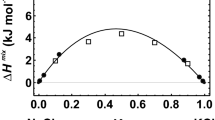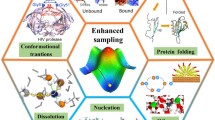Abstract
The stability of the body- and face-centered cubic lattices corresponding to the α and γ phases of Fe, respectively, as well as the transformation of one phase to the other were investigated by atomistic simulations. Two interatomic potentials were used: the embedded atom method (EAM) potential of Meyer and Entel and the bond order potential (BOP) developed by Müller et al. The suitability of the potentials for investigating structural transformations in Fe was verified using nonequilibrium free energy calculations and molecular dynamics simulations. The results showed that the EAM potential is capable of describing the bcc → fcc and fcc → bcc transformations whereas no transformation was observed for the computationally more expensive BOP potential with the simulation set up used.














Similar content being viewed by others
References
M.S. Daw, S.M. Foiles, and M.I. Baskes, The Embedded-Atom Method: A Review of Theory and Applications, Mater. Sci. Rep., 1993, 9(7–8), p 251-310
D.G. Pettifor, Bonding and Structure of Molecules and Solids, Oxford University Press, Oxford, 1995
T.B. Massalski and D.E. Laughlin, The Surprising Role of Magnetism on the Phase Stability of Fe (Ferro), Calphad, 2009, 33(1), p 3-7
H. Hasegawa and D.G. Pettifor, Microscopic Theory of the Temperature-Pressure Phase Diagram of Iron, Phys. Rev. Lett., 1983, 50(2), p 130-133
R. Meyer and P. Entel, Martensite Austenite Transition Phonon Dispersion Curves Fe1-xNix Studied by Molecular Dynamics Simulations, Phys. Rev. B, 1998, 57(9), p 5140-5147
M.I. Mendelev, S. Han, D.J. Srolovitz, G.J. Ackland, D.Y. Sun, and M. Asta, Development of New Interatomic Potentials Appropriate for Crystalline and Liquid Iron, Philos. Mag., 2003, 83(35), p 3977-3994
S.L. Dudarev and P.M. Derlet, A ‘Magnetic’ Interatomic Potential for Molecular Dynamics Simulations, J. Phys.: Condens. Matter, 2005, 17(44), p 7097
P.M. Derlet and S.L. Dudarev, Million-Atom Molecular Dynamics Simulations of Magnetic Iron, Prog. Mater Sci., 2007, 52(2–3), p 299-318
S. Chiesa, P.M. Derlet, S.L. Dudarev and H. van Swygenhoven, Optimization of the Magnetic Potential for alpha-Fe, J. Phys. Condens. Matter, 2011, 23(20), art. 206001
R. Drautz and D.G. Pettifor, Valence-Dependent Analytic Bond-Order Potential for Transition Metals, Phys. Rev. B, 2006, 74(17), art. 174117
R. Drautz and D.G. Pettifor, Valence-Dependent Analytic Bond-Order Potential for Magnetic Transition Metals, Phys. Rev. B, 2011, 84(21), art. 214114
M. Müller, P. Erhart and K. Albe, Analytic Bond-Order Potential for bcc and fcc Iron—Comparison with Established Embedded-Atom Method Potentials, J. Phys. Condens. Matter, 2007, 19(32), art. 326220
S. Plimpton, Fast Parallel Algorithms for Short-Range Molecular Dynamics, J. Comput. Phys., 1995, 117(1), p 1-19
S. Nosé, A Unified Formulation of the Constant Temperature Molecular Dynamics Methods, J. Chem. Phys., 1984, 81(1), p 511-519
W. Hoover, Canonical Dynamics: Equilibrium Phase-Space Distributions, Phys. Rev. A, 1985, 31(3), p 1695-1697
M. Parrinello and A. Rahman, Crystal Structure and Pair Potentials: A Molecular-Dynamics Study, Phys. Rev. Lett., 1980, 45(14), p 1196-1199
M. Parrinello and A. Rahman, Polymorphic Transitions in Single Crystals: A New Molecular Dynamics Method, J. Appl. Phys., 1981, 52(12), p 7182-7190
C. Engin and H.M. Urbassek, Molecular-Dynamics Investigation of the fcc-bcc Phase Transformation in Fe, Comput. Mater. Sci., 2008, 41, p 297-304
R. Freitas, M. Asta, and M. de Koning, Nonequilibrium Free-Energy Calculation of Solids using LAMMPS, Comput. Mater. Sci., 2016, 112, p 333-341
R. Meyer and P. Entel, Lattice Dynamics of Martensitic Transformations Examined by Atomistic Simulations, J. Phys. IV, 1997, 7(C5), p C5-29-C5-34
M. Shimono, H. Onodera, and T. Suzuki, FCC-BCC Phase Transition in Iron Under a Periodic Boundary Condition, Mater. Trans., JIM, 1999, 40(11), p 1306-1313
C. Bos, J. Sietsma, and B.J. Thijsse, Molecular Dynamics Simulation of Interface Dynamics during the fcc-bcc Transformation of a Martensitic Nature, Phys. Rev. B, 2006, 73(10), art. 104117
H. Song and J.J. Hoyt, A Molecular Dynamics Simulation Study of the Velocities, Mobility and Activation Energy of an Austenite-Ferrite Interface in Pure Fe, Acta Mater., 2012, 60, p 4328-4335
H. Song and J.J. Hoyt, An Atomistic Simulation Study of the Migration of an Austenite-Ferrite Interface in Pure Fe, Acta Mater., 2013, 61, p 1189-1196
H. Song and J.J. Hoyt, A Molecular Dynamics Study of Heterogeneous Nucleation at Grain Boundaries during Solid-State Phase Transformations, Comput. Mater. Sci., 2016, 117, p 151-163
H. Song and J.J. Hoyt, Barrier-Free Nucleation at Grain-Boundary Triple Junctions During Solid-State Phase Transformations, Phys. Rev. Lett., 2016, 117(23), art. 238001
M. Watanabe and W. Reinhardt, Direct Dynamical Calculation of Entropy and Free Energy by Adiabatic Switching, Phys. Rev. Lett., 1990, 65(26), p 3301-3304
M. de Koning and A. Antonelli, Einstein Crystal as a Reference System in Free Energy Estimation Using Adiabatic Switching, Phys. Rev. E, 1996, 53(1), p 465-474
M. de Koning and A. Antonelli, Adiabatic Switching Applied to Realistic Crystalline Solids: Vacancy-Formation Free Energy in Copper, Phys. Rev. B, 1997, 55(2), p 735-744
D. Frenkel and A.J.C. Ladd, New Monte Carlo Method to Compute the Free Energy of Arbitrary Solids. Application to the fcc and hcp Phases of Hard Spheres, J. Chem. Phys., 1984, 81(7), p 3188-3193
D. Frenkel and B. Smit, Understanding Molecular Simulation: from Algorithms to Applications, Academic Press, Cambridge, 2002
J. Li, AtomEye: An Efficient Atomistic Configuration Viewer, Model. Simul. Mater. Sci. Eng., 2003, 11(2), p 173-177
Acknowledgments
R. G. A. Veiga and J. E. Guimarães Silva gratefully acknowledge funding by FAPESP Grant 2014/10294-4. M. G. Di V. Cuppari was awarded a postdoctoral fellowship at Ecole Nationale Superieure de Chimie de Lille within the action CAPES/COFECUB 770/13. The authors would like to acknowledge computing time provided on the Blue Gene/Q supercomputer supported by the Research Computing Support Group (Rice University) and Laboratório de Computação Científica Avançada (Universidade de São Paulo).
Author information
Authors and Affiliations
Corresponding author
Additional information
This article is an invited paper selected from presentations at TOFA 2016, the Discussion Meeting on Thermodynamics of Alloys, held September 4-9, 2016, in Santos, Brazil, and has been expanded from the original presentation.
Appendix: Free Energy Calculations
Appendix: Free Energy Calculations
Free energy computations in atomistic simulations for solids are usually calculated as the free energy difference between a solid and a reference system with known free energy. In this work, a nonequilibrium method will be used to calculate the free energy of solids described by different interatomic potentials (EAM or BOP). This method is discussed in detail in Ref 27-29 and only an outline will be given here. The starting point for all free energy calculations is the Helmholtz potential (free energy), F, which can be expressed in terms of the canonical partition function:
In Eq 1 k is the Boltzmann constant, T is temperature and Z is the canonical partition function given by:
Since the determination of the partition function, Z can be done analytically only in a few simple systems, it is more useful to consider the free energy differences rather than absolute values. The free energy difference between two systems with partition functions Z and Z0 can be written as:
Note that in Eq 3 the free energy difference depends on the partition function ratio and not on individual partition functions. The two systems can differ in several ways and may be defined by two different Hamiltonians (interatomic potentials). Consider now two systems defined by a Hamiltonian that depends on an external parameter λ. In this case:
The derivative of F with respect to λ will give:
Since the partition function, Z, is given by Eq 2, it can be shown (if the particle masses of the two systems are the same) that:
In Eq 6 above <···>λ indicates an average taken at fixed value of λ. In the most general case, H (p, q, λ) can be defined by the following equation:
The most common choice for the reference system is the (an Einstein crystal). The method outlined above is called Thermodynamic Integration Method. In this method an external parameter, λ, is used to slowly change the system of interest into another with known free energy, typically a harmonic solid where each atom is fixed to its lattice position by a harmonic spring and with no intermolecular interactions. Frenkel and Ladd[30] used the procedure outlined above to calculate the free energy differences between solids using as reference a harmonic solid. This method requires a great number of simulations at several values of the coupling parameter, λ, followed by numerical integration to obtain the free energy of the system of interest. Nonequilibrium methods on the other hand, allow the determination of the free energy in a single simulation.
In nonequilibrium methods the coupling parameter is an explicit function of time λ = λ(t) and the free energy can be computed using Eq 8:
The free energy of the harmonic crystal used in the work is calculated with the following equation:
where ΛE is the harmonic constant of the Einstein crystal and Λ is the thermal de Broglie wavelength. ΛE is a critical parameter and cannot be arbitrarily set. In the present work, the value of ΛE was calculated using the following formula:[31]
where m is the mean-squared displacement at temperature T.
The adiabatic switching method was used to calculate free energy differences between the fcc and bcc phases of Fe. In the nonequilibrium runs each configuration was kept at value of λ = 0 for 0.1 ns. After this period, λ is changed continuously from 0 to 1 according to the function:
The switching is done in this is done in 0.9 ns. Then comes the second equilibration period where the system is kept in the λ = 1 state for 0.1 ns. After that, the system returns to its initial condition in 0.9 ns. The use of integration in both directions is performed to try to eliminate the dissipated heat due to nonequilibrium process and the free energy difference is calculated using an average of the forward and backward directions.
Rights and permissions
About this article
Cite this article
Cuppari, M.G.V., Veiga, R.G.A., Goldenstein, H. et al. Lattice Instabilities and Phase Transformations in Fe from Atomistic Simulations. J. Phase Equilib. Diffus. 38, 185–194 (2017). https://doi.org/10.1007/s11669-017-0524-0
Received:
Revised:
Published:
Issue Date:
DOI: https://doi.org/10.1007/s11669-017-0524-0




